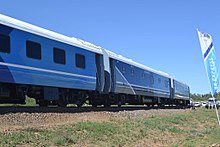Transport in Botswana
This article was imported from the CIA's World Factbook. |


A sparsely populated, arid country, Botswana has nonetheless managed to incorporate much of its interior into the national economy. An "inner circle" highway connecting all major towns and district capitals is completely paved, and the all-weather Trans-Kalahari Corridor Highway connects the country (and, through it, South Africa's commercially dominant Gauteng Province) to Walvis Bay in Namibia.
Railways
BR Express


All passenger services were discontinued in 2009, with the only remaining service being an international link to Zimbabwe from Francistown. Freight trains still operate. Passenger service was expected to resume in late 2015.[1] Passenger services were later re-introduced in March 2016.
Freight trains
Over half of BRs freight traffic is in coal, grain and intermodal freight, and it also ships automative parts and assembled automobiles, sulphur, fertilizers, other chemicals, soda ash, forest products and other types of the commodities.
Regional trains
Botswana Railways run 2 nightly passenger trains, one from Lobatse to Francistown, and the other from Francistown to Lobatse, with stops in Gaborone, Mahalapye, Palapye, and Serule. The passenger train is termed the "BR Express" (Botswana Railways).
Commuter/Suburban trains
In Botswana, the (Botswana Railways) "BR Express" has a commuter train between Lobatse and Gaborone. The train is scheduled to depart in Lobatse at 0530hrs and arrive at Gaborone 0649hrs. This train return to Lobatse in the evening, well departing in Gaborone at 1800hrs. Arrival time at Lobatse is 1934hrs.
The train stops at Otse, Ramotswa and Commerce Park Halt.
BR Express Sleeping & Dining Department

The BR decided from the very beginning that it would operate its own sleeping cars. Bigger - sized berths and more comfortable surroundings were built. Providing and operating their own cars allowed better control of the service provided as well as revenue received, although profit was never a direct result of providing food to passengers. Rather, it was for those who could afford to travel great distances expected such facilities and favourable opinion would - well attracting others to Botswana and the BR's trains.
Locomotives


Diesel locomotives
As of March 2009
- 8 General Electric UM 22C diesel-electric locomotive, 1982.
- 20 General Motors Model GT22LC-2 diesel-electric locomotive, 1986.
- 10 General Electric UI5C diesel-electric locomotive, 1990.
8 new gt142aces delivered in 2017 from emd.
Network

Botswana possesses 888 km of 1,067 mm (3 ft 6 in) gauge railway, by 2019 figures, serving a number of towns and connecting the country to its neighbors.
Highways
Botswana possesses 10,217 km of highway, of which 5,620 km are paved. Since 1996 estimates, there has been a significant reduction in the total length of unpaved highway in Botswana - between 1996 and 1999 total length of unpaved highway fell from 14,139 km to 4,597 km.
Traditionally, road signs in Botswana used blue backgrounds rather than the yellow, white, or orange that the rest of the world uses on traffic warning signs. In the early 2010s, officials announced plans to begin phasing out the distinctive blue signs in favor of more typical signs in order to be more in line with the neighboring Southern African Development Community member states.[2]
Interchanges
Existing
- Thapama Interchange at the junction of A1 / Blue Jacket Street and A3 in Francistown.[3][4]
Proposed
- Boatle Interchange in Gaborone, its map plan (phase one) it's done, and the tendering of the project, it's done (phase two) and the groundbreaking or construction (phase three) has commenced.
Airports

In 2004 there were an estimated 85 airports, 10 of which (as of 2005), were paved. The country's main international airport is Sir Seretse Khama International Airport in Gaborone. The government-owned Air Botswana operates scheduled flights to Francistown, Gaborone, Maun, and Selebi-Phikwe. There is international service to Johannesburg, South Africa; Mbabane, Swaziland; and Harare, Zimbabwe. A new international airport near Gaborone was opened in 1984. Air passengers arriving to and departing from Botswana during 2003 totalled about 183,000.
International Airports
Botswana has 4 international airports. The following are:
Existing
- Kasane Airport in Kasane.
- Maun Airport in Maun.
Proposed
- "Mophane International Airport" is yet to be established in Palapye Sub-District near Moremi village.
Sea Port
Botswana is a landlocked country with no access to the sea.
Ferries

Kazungula Ferry is a pontoon ferry that crosses 400 metres (1,300 ft) wide Zambezi River between Botswana and Zambia.
Border Posts

- Bokspits Border Post
- Kazungula Border Post
- Ramatlabama Border Post
- Ramokgwebana Border Post
- Mamuno Border Post
- Pandamatenga Border Post
See also
External links
References
- ^ Passenger train is coming back, Tue 09 Dec 2014, Mmegi Online, http://www.mmegi.bw/index.php?aid=47955
- ^ "Mmegi Online" staff writer Maranyane Ngwanaamotho (Dec 21, 2011). "Old road signs are being phased out". Archived from the original on November 29, 2012. Retrieved Oct 5, 2012.
{{cite web}}: Unknown parameter|dead-url=ignored (|url-status=suggested) (help) - ^ Ketumile, Kesentse (Jan 25, 2016). Botswana Daily News Hello spaghetti, bye bye traffic circles http://www.dailynews.gov.bw Hello spaghetti, bye bye traffic circles. Retrieved Oct 4, 2016.
{{cite web}}: Check|url=value (help); Italic or bold markup not allowed in:|newspaper=(help); Missing or empty|title=(help) - ^ ""Francistown Spaghetti Junction Opens for Public Use"". The Midweek Sun. Dec 16, 2016. Retrieved Oct 4, 2017.[permanent dead link]
